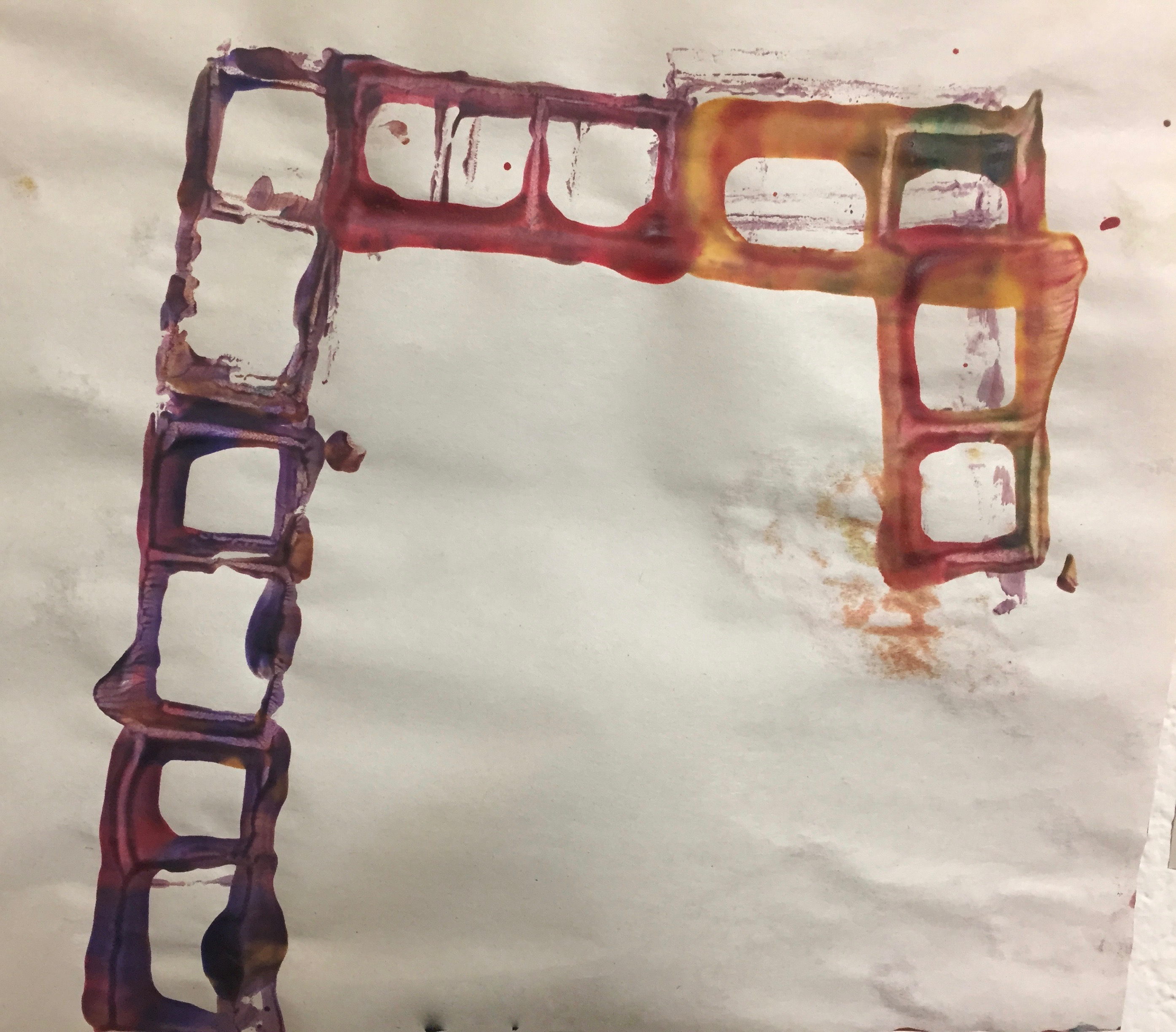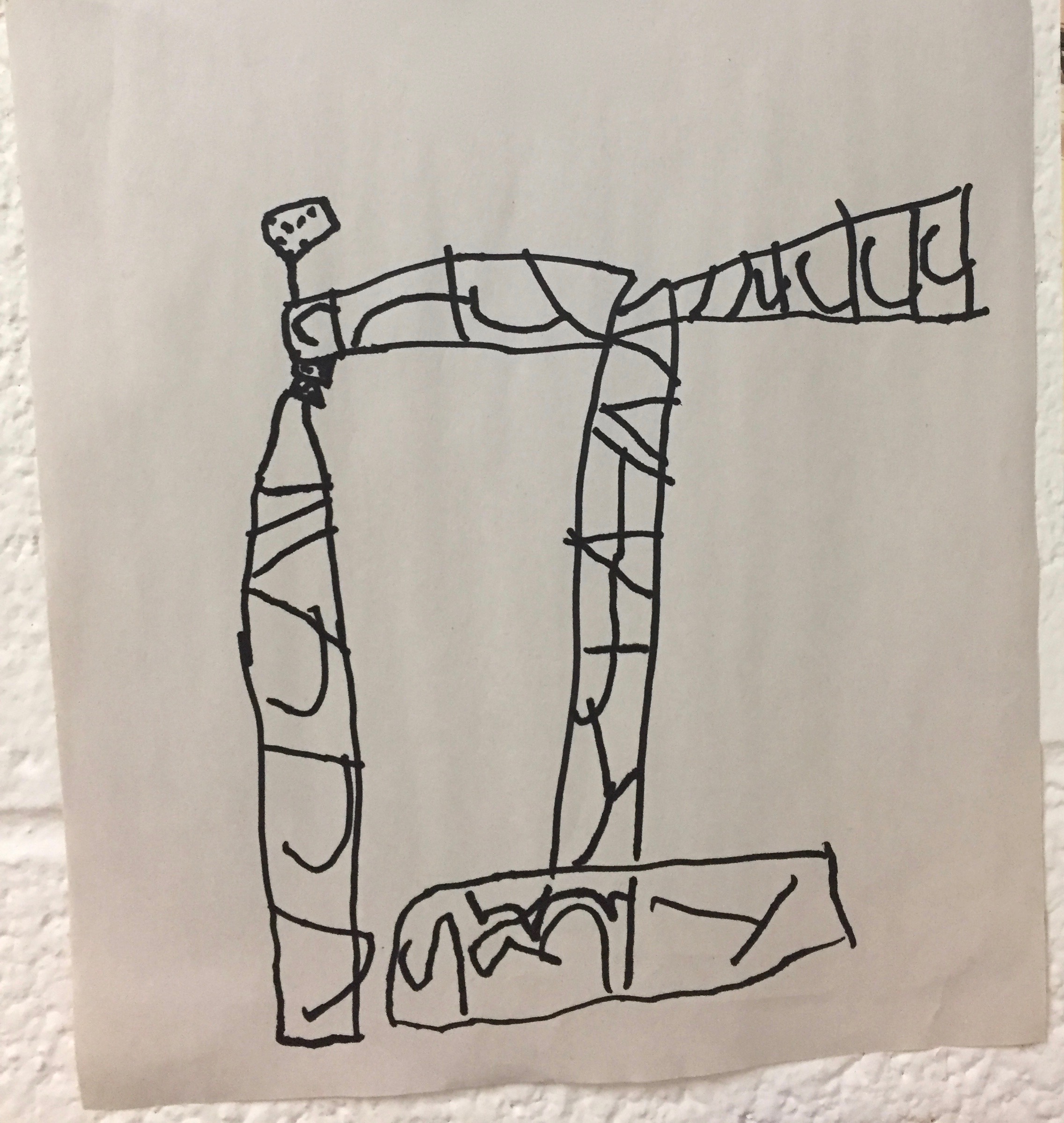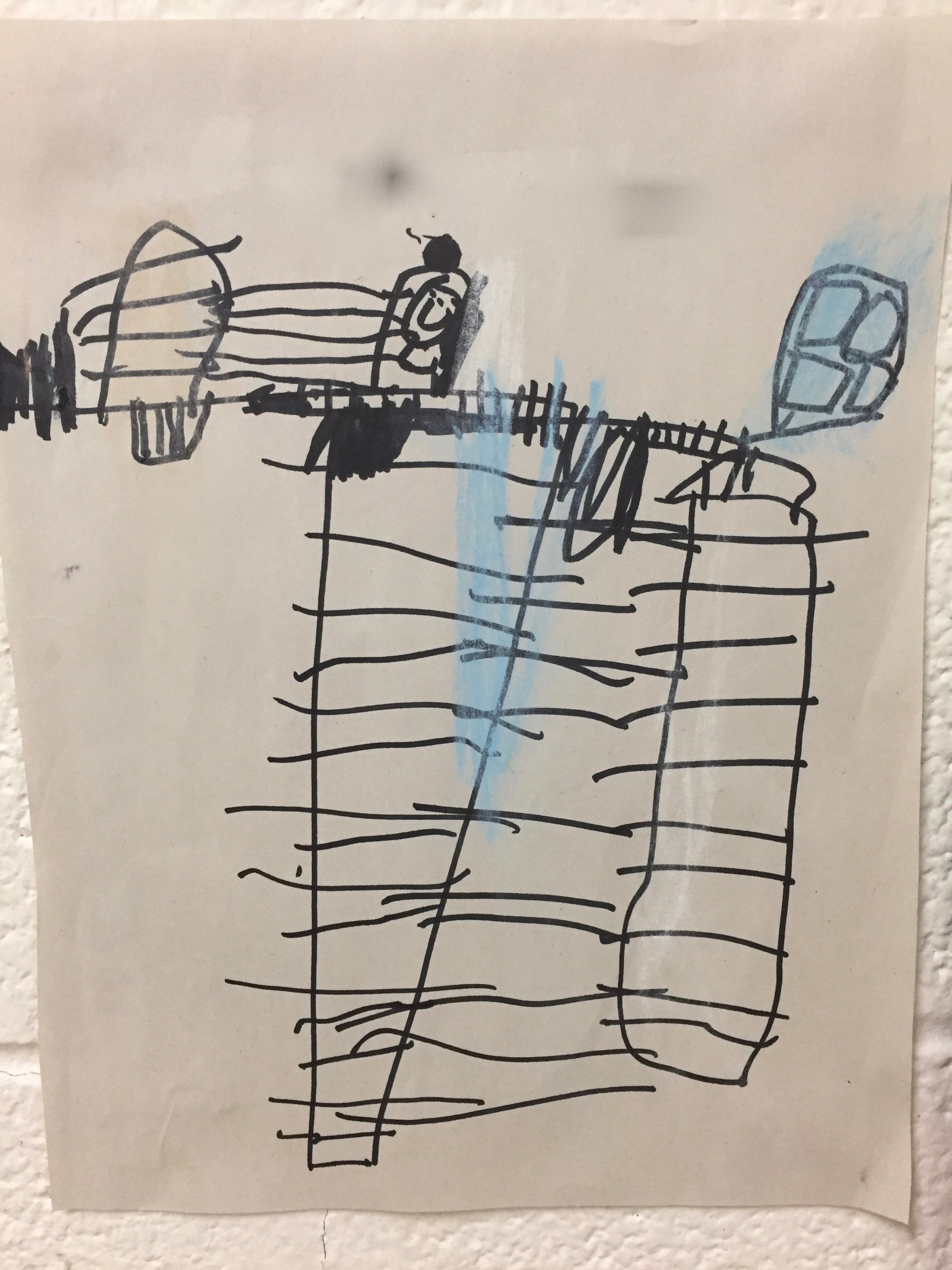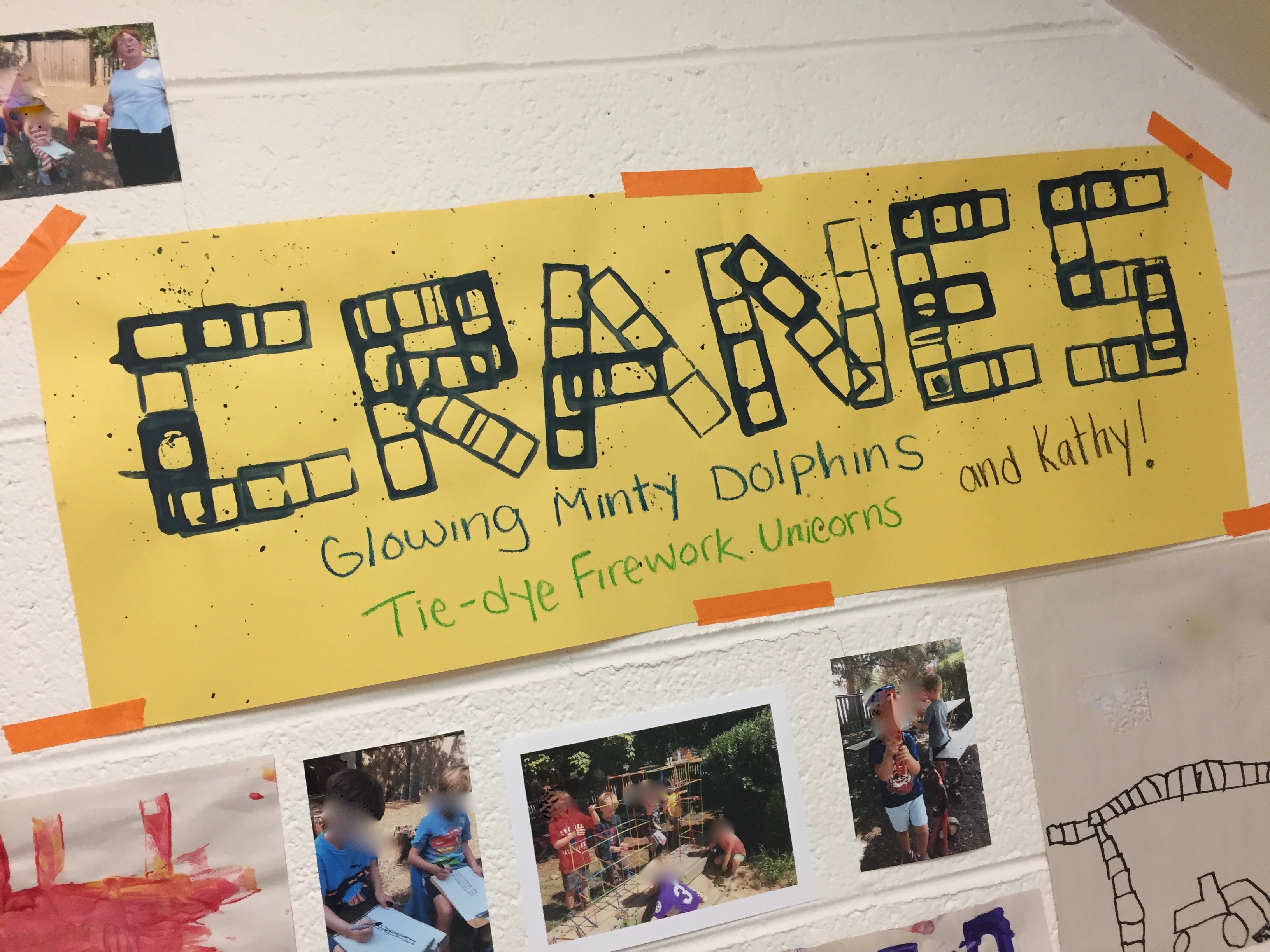Experts Agree: Connecting STEM Learning and Teaching Works!
By Carole Hayward
Posted on 2019-11-13
On December 7, NSTA is offering a virtual conference designed to bring together some of the best thinkers in the field focused on learning and teaching by connecting in-school and out-of-school STEM experiences.
Why create collaborative STEM experiences? Because no one school, museum, organization, camp, or after-school program can give students and teachers the space, resources, and experiences that will motivate and challenge participants the way you can when school and outside groups work together. That’s why blended STEM learning experiences that connect in-school and out-of-school learning are a key recommendation in the recently released America’s Strategy for STEM Education.*
How Do You Start a Connected STEM Program?
Join NSTA for a virtual conference (Connecting In-school and Out-of-school STEM Learning and Teaching) to meet fellow teachers, STEM program managers, NSTA’s President, NSTA’s Executive Director, authors, and other experts in the field. Learn how they have created programs, what they recommend for those just getting started, where to find collaborators and funding, and ways to gain support for your ideas. Best of all, as you interact with presenters and fellow attendees during this conference, you’ll be expanding your network and meet people who you can count on for help along the way!
Why Learning and Teaching?
Teaching and learning are closely correlated, so good teachers generally make good learners, and vice versa. Throughout this virtual conference, participants will get a chance to see models of both roles, and learn to engage students with diverse learning styles. This matters because understanding how to involve all stakeholders, gain their attention, and keep them invested is critical for connecting in-school and out-of-school learning. And this type of collaboration will be of long-term importance to students (and to society in general), because it models and teaches the skills and working styles that will be needed for jobs of the future (the very near future).
And just as there are diverse learning styles, educators have diverse needs. Here are just a few of the reasons people tell us they sign up for virtual conferences:
- “I am a neophyte to STEM, but hope to implement a STEM club after school.”—Laura B.
- “[I want to] improve STEM and engage more students in STEM. “—Donald B.
- “NSTA Virtual Conferences are a wonderful way to do amazing Professional Development from the comfort of home.”—Dorothy G.
- “My biggest challenges have been projects that students are engaged in and ideas for k-2 students.”—Jeremy M.
- “We are doing quite a bit of STEM work in our region and part of my job is working with administrators and teachers, district and community to help them get STEM education implementation going in our region.”—Georgia B.
Dorothy G. mentioned one of her favorite things about NSTA virtual conferences (comfort), so it’s worth noting that participants can log on from anywhere with an internet connection and interact with presenters and educators from across the country.
Ready to sign up for a day of impactful learning that will improve your teaching for a lifetime? Learn more about Connecting In-School and Out-of-School STEM Learning and Teaching; view the agenda; and discover who’s presenting.
On December 7, NSTA is offering a virtual conference designed to bring together some of the best thinkers in the field focused on learning and teaching by connecting in-school and out-of-school STEM experiences.
Brief
Defining and Measuring STEM Identity and Interest in STEM Learning
Connected Science Learning October-December 2019 (Volume 1, Issue 12)
By Jamie Bell, Kevin Crowley, Martin Storksdieck, John Besley, Matthew A. Cannady, Amy Grack Nelson, Tina Phillips, Kelly Riedinger, and Melissa Ballard
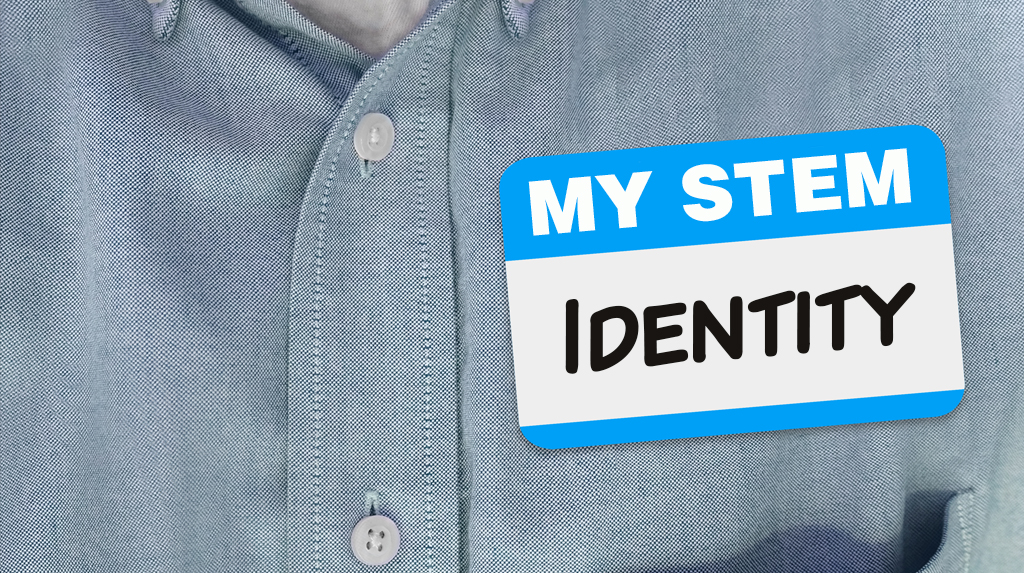
A growing number of educators are focused on increasing students’ interest in and developing their identity in relation to science, technology, engineering, and math (STEM) as an intended outcome of their out-of-school activities and programs.
In everyday language, one might define identity as the way that people answer questions such as: “Who do I think I am, or who can I be? Where do I belong? How do I think other people see me?” People who are developing identities related to STEM will navigate questions such as these along the way.
Interest is a complex concept to define; because the term is used in everyday language, it can be laden with personal meanings. But, researchers generally agree that interest can be described as a long-term pattern of choices and pursuits, and has a multidimensional structure that includes affective, intellectual, and social components.
An evolving field of research
The landmark National Research Council report, Learning Science in Informal Environments: People, Places, and Pursuits (2009) posited that learners in informal environments “experience excitement, interest, and motivation to learn about phenomena in the natural and physical world” and that informal learning experiences position participants to “think about themselves as science learners and develop an identity as someone who knows about, uses and sometimes contributes to science.”
Over the past 10 years, researchers across STEM education, the learning sciences, social psychology, and science communication have been working to understand and build models of STEM interest and identity, and how out-of-school education experiences foster these constructs. The Center for Advancement of Informal Science Education (CAISE)’s Evaluation and Measurement Task Force recently conducted a series of interviews with 23 experts to take a snapshot of current research and thinking around these concepts. For each expert we interviewed, you can find a short video clip, interview highlights, and the full interview transcript online. There are also summary documents for identity and interest. Below are some highlights of what we learned.
Identity
When people engage with STEM, where they are on a continuum of STEM identity influences their expectations of how interesting and successful the experience will be. If they find an activity to be engaging and satisfying, the experience may strengthen their STEM identity, leading to a positive feedback loop that can reinforce ongoing participation and learning. Conversely, when learners have less engaging or unsuccessful experiences, a negative feedback loop can result—and might erode a developing STEM identity and make it less likely a learner will choose to participate in related activities in the future.
Across the interviews, there were varied opinions regarding whether identity can actually be measured or observed. Some researchers noted that a variety of data collection strategies can provide some evidence of aspects of an individual’s identity, including open-ended interviews, observations of learners, long-term ethnographic studies, implicit association tests, or self-report surveys. Several of the interviewees reminded us that these data collection efforts capture only a snapshot of an individual’s identity in a moment and a context.
Interest
Several researchers we spoke with, who work in informal STEM education, use Hidi and Renninger’s Four-Phase Model of Interest Development (2010), in which initial “triggered situational interest,” with sufficient support, becomes “maintained situational interest,” developing over time into “emerging individual interest” and ultimately “well-developed individual interest.”
We also heard insights such as the importance of taking into account historical and cultural factors that affect interest development in different populations, and that building and supporting ecosystems with multiple, varied, and connected opportunities for exposure and engagement are key for STEM interest to take hold. Some researchers don’t use the term “interest,” and instead used terms such as “preference” or “choice” to describe the same or similar phenomena. Researchers studying what they call the “activation” of learners conceptualize interest as consisting of (at least) two dimensions: fascination and value.
Interest is often measured using surveys that directly ask individuals to rate their preference for a particular topic or activity type. However, many researchers continue to debate self-reports—whether they are objective, how robust they are over time and within different contexts, and how much they can actually tell us about an individual’s interest. One alternative to using surveys is conducting open-ended interviews that reveal a more nuanced picture of the role of interest in learning, or ethnographic studies that track the development or loss of interest over time. Some researchers are studying “family interest pathways” by piloting strategies such as video observations, family-created journals, and artifacts.
More resources
- In August 2019, CAISE hosted a webinar during which our task force members highlighted the perspectives from the interviews that they found most striking. We also responded to audience questions related to capturing longitudinal outcomes, and whether one should be thinking about a more generalized STEM identity or interest, or if discipline-specific measures are important to consider. Watch the recording on our YouTube channel and download the presentation slides.
- InformalScience.org also has several evaluation-related resources, including our “Design Evaluation” guide, a list of evaluation tools and instruments, and a recent blog post that gathers evaluation resources from across the web.
Jamie Bell (jbell@informalscience.org) is project director and principal investigator at the Center for Advancement of Informal Science Education in Washington, DC. Kevin Crowley (crowleyk@pitt.edu) is professor of learning sciences and policy at the University of Pittsburgh in Pittsburgh, Pennsylvania, and co–principal investigator at the Center for Advancement of Informal Science Education in Washington, DC. Martin Storksdieck (storksdieck@oregonstate.edu) is director of the Center for Research on Lifelong STEM Learning at Oregon State University in Corvallis, Oregon, and co–principal investigator at the Center for Advancement of Informal Science Education in Washington, DC. John Besley (jbesley@msu.edu) is professor of public relations and advertising at Michigan State University in East Lansing, Michigan. Matthew A. Cannady (mcannady@berkeley.edu) is research group director at The Lawrence Hall of Science, University of California, Berkeley, in Berkeley, California. Amy Grack Nelson (agnelson@smm.org) is evaluation and research manager at the Science Museum of Minnesota in St. Paul, Minnesota. Tina Phillips (cbp6@cornell.edu) is evaluation program manager at the Cornell Lab of Ornithology in Ithaca, New York. Kelly Riedinger (kelly.riedinger@oregonstate.edu) is senior researcher at the Center for Research on Lifelong STEM Learning at Oregon State University in Corvallis, Oregon. Melissa Ballard (mballard@informalscience.org) is communications and community manager at the Center for Advancement of Informal Science Education in Washington, DC.
<i>“Why Do We Need to Know This?!”</i>
By Gabe Kraljevic
Posted on 2019-11-11
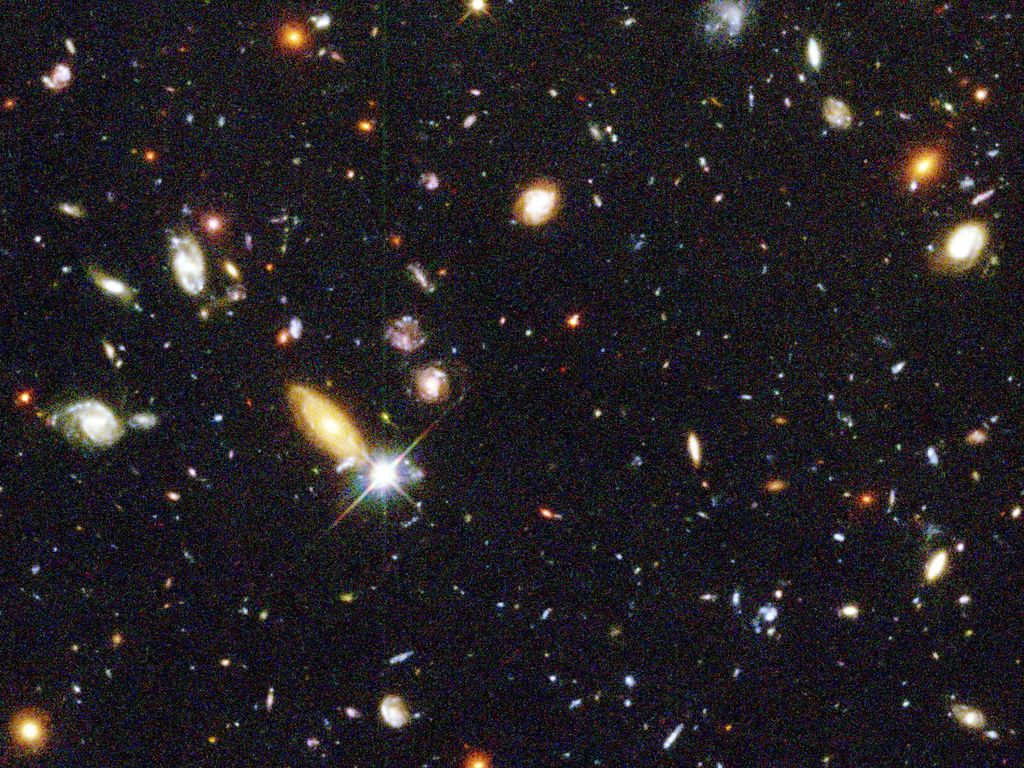
Hubble Deep Field Image
How do you explain to your students that what you’re teaching is important even if there is no obvious real-world application?
— B., Ohio
I’m sure every teacher has heard this refrain!
I found that students question what we teach when it is dull and repetitive. So, trying different strategies may work.
You can appeal to them on a philosophical level: explain to them that most of us don’t know what may be personally useful n the future.
The history of science is full of discoveries that were ahead of their time. It took time and the right people to reveal the importance or usefulness of that knowledge. Classic stories you can relate to your students: Michael Faraday and electromagnetism; Wilhelm Roentgen and X-rays; Alexander Flemming and penicillin; and many more.
My favorite is Christian Doppler who, in 1847, studied and determined why sound coming towards you is higher pitched than when it moves away from you (think race cars). Twenty years later astronomers discovered that the light followed the “Doppler Effect” and they could identify stars moving away or toward our solar system. In 1929, Edwin Hubble’s observations of galaxies indicated that they were all moving away from each other at ever-increasing velocity. This is the basis for the “Big Bang” theory, part of our current model of the universe. From Doppler’s curiosity about how train whistles change pitch we now have the current theory of the cosmos!
As a last resort, you can always just say the people who write curriculum felt it was important to understand. They can always complain to the government.
Hope this helps!
Image Credit: NASA/JPL/STScI Hubble Deep Field Team

Hubble Deep Field Image
How do you explain to your students that what you’re teaching is important even if there is no obvious real-world application?
— B., Ohio
I’m sure every teacher has heard this refrain!
Science Festivals Focus on Community, Diversity
By Lynn Petrinjak
Posted on 2019-11-06
According to Marc Schulman, executive director of the USA Science and Engineering Festival (USASEF), “the modern era of science festivals…was kicked into gear” when the National Science Foundation (NSF) awarded a grant to four institutions in 2009 to support the creation of three science festivals modeled on the Cambridge Science Festival: one each in the San Francisco Bay area and San Diego, California; and Philadelphia, Pennsylvania.
“Science festivals are really about having a spot for science on the cultural calendar, the cultural stage,” asserts Ben Wiehe, manager of the Science Festival Alliance (SFA) at MIT. “They’re about bringing people together around science and technology and a shared identity of how science makes us who we are.” Because the best science festivals are “extremely responsive to cultural geography,” Wiehe describes his role at SFA as helping members consider what’s important to their communities and form goals around that, rather than focusing on an institution’s own outreach goals. He advises organizers to reflect on “what will give [attendees] new memorable, fresh experiences.…This is ultimately about trying to create a community-wide event. You have to see how people come together in your community, what gives them a sense of pride, how they come together for work or play.” He asks them, “What’s a good inside joke for your area?”
SFA, which grew out of the original NSF grant, now includes 63 member festivals. Many of SFA’s members started with grants from the alliance’s Science Festival Accelerator, which provides professional development and up to $10,000 in matching funds to “new or significantly expanded festival initiatives that focus on areas or communities with relatively small resource space,” Wiehe explains, noting that 2019 Accelerator applications are being accepted through December 2.
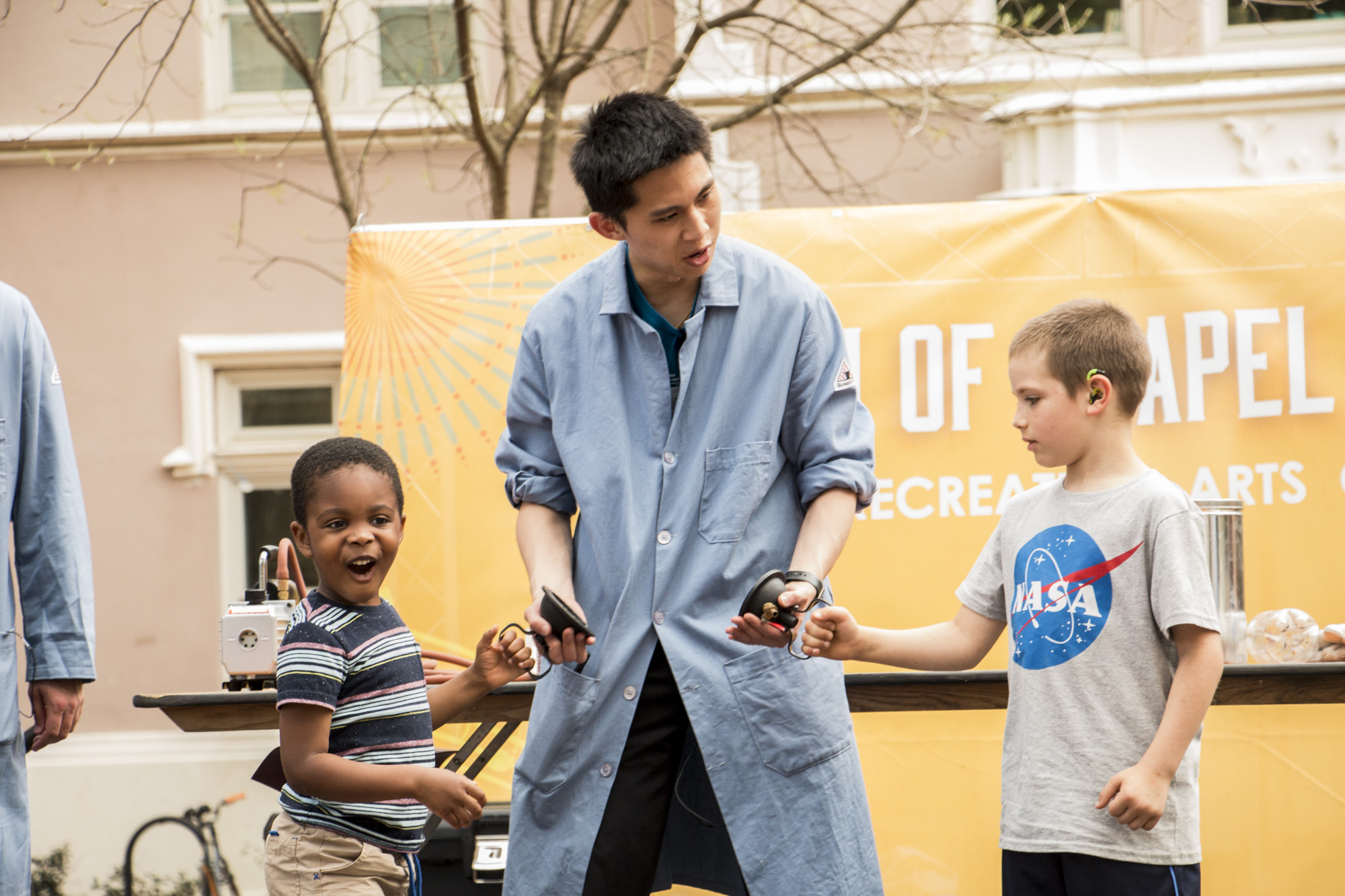
Chapel Hill, Science Expo, part of the North Carolina Science Festival. Photo courtesy of Morehead Planetarium and Science Center.
Director Jonathan Frederick says he considers the North Carolina Science Festival as erecting “a science circus tent over the state,” with events at more than 250 K–12 schools, and 150 public event partners producing more than 400 events statewide. “We’re trying to connect science to everyday life,” he says. “Our audience is the 10+ million people of North Carolina.” Public events range from urban geology hikes to skywatching at rooftop restaurants to art conservation programs focused on chemistry and biochemistry at museums.
“We have a science night program, with the ambition to be in every elementary school in the state. Each year we send out boxes of supplies [from a library of 40 activities],” Frederick says. Each school receives supplies for 10 different stations and 200 participants. “Some schools in more rural areas may only have 60 people show up; they use the rest of the supplies at the schools. Others have 600 people show up; they use our kits as a ‘starter pack’ and go from there.”
In addition, the festival includes events at university campuses and science centers, such as a science street fair at University of North Carolina, Chapel Hill, and the Gravity Games sponsored by Google and Appalachian State University.
The ninth Wisconsin Science Festival (WSF) was held in October. “We have seen tremendous growth in organic interest, the number of communities interested in participating,” says Laura Heisler, cofounder and director. “The very first year, we kept it within Madison;…the expansion became organic with different organizations. Communities across Wisconsin have embraced it…We share resources, advice, and contacts.”
Rather than planning events for various communities, Heisler says her group invites organizers at the community level to share what they’re doing and the science connection, and WSF shares the events on their website and social media and provides T-shirts, a banner, and other promotional items. When they “hit a critical mass” in an area, WSF will buy local advertising to support the events.
WSF also participates in EvalFest, a five-year study of 25 science festivals to develop evaluation tools. “We’ve learned there is great value when people interact with scientists. People don’t realize how much science is in their state,” says Heisler, who is excited to see the results of the study, expected to be completed this year.
A National Stage
“There are different styles of festivals,” says USASEF’s Schulman. Many are connected to specific institutions or last for two weeks or longer with events spread across a large area, attracting local or regional audiences. “Our model is a little different…Ours attracts people from across the country…We’re trying to be like a lightning bolt. Everything you see at [the USASEF] is what you could see at others if you were go to all their events,” he contends. The sixth USASEF will be held April 23–26, 2020, in Washington, D.C.
Held every other year, the four-day USASEF features “650 organizations including nonprofits, [130] government agencies, colleges and universities, professional
societies, and corporations,” many of which bring chemists, engineers,
and other STEM professionals from facilities around the country. Exhibitors are arranged in “topical pavilions” such as national security, health and medical, and exploration. “We try to showcase the diversity in [science, technology, engineering, and mathematics]
STEM jobs and STEM careers. We’re trying to cover the gamut of what STEM jobs look like—including skilled trades/advanced manufacturing,” says Schulman. “We’re constantly
trying to push boundaries of what we would consider a STEM career.”
On the first day, USASEF hosts X-STEM, which Schulman describes as “a TED talk” for about 4,000 middle and high school students. “Sneak Peek Friday” is reserved for K–12 school groups, with the final two days open to the public. The 2018 festival drew
375,000 attendees on the final three days, leading Schulman to conclude “we’re at capacity…Booths have 30,000–40,000 people come through.”
After witnessing attendees struggling to reach various exhibitors due to the large crowd, USASEF will add a registration system for the 2020 festival. “It’s not good for attendees when it’s too crowded. They can’t get to what they want to see. It’s not good for organizations; they can’t talk to everyone when they’re jammed up,” Schulman says. A nominal fee will be charged for attendees older than 18; registration for attendees younger than 18 will be free.
While the impact is hard to measure, Schulman is confident science festivals are an important “response to the lack of STEM education in American public schools.” He explains, “I have a science event that gets 300,000 people…Some debate if a festival is a good investment. I tell people, if [festivals] are not working, why are 300,000 people here; 50,000 people [at other science festivals]? It does work; I just can’t give metrics as to how it works.”
This article originally appeared in the November 2019 issue of NSTA Reports, the member newspaper of the National Science Teachers Association. Each month, NSTA members receive NSTA Reports, featuring news on science education, the association, and more. Not a member? Learn how NSTA can help you become the best teacher of science you can be.
According to Marc Schulman, executive director of the USA Science and Engineering Festival (USASEF), “the modern era of science festivals…was kicked into gear” when the National Science Foundation (NSF) awarded a grant to four institutions in 2009 to support the creation of three science festivals modeled on the Cambridge Science Festival: one each in the San Francisco Bay area and San Diego, California; and Philadelphia, Pennsylvania.
When a construction site is next door
By Peggy Ashbrook
Posted on 2019-11-05
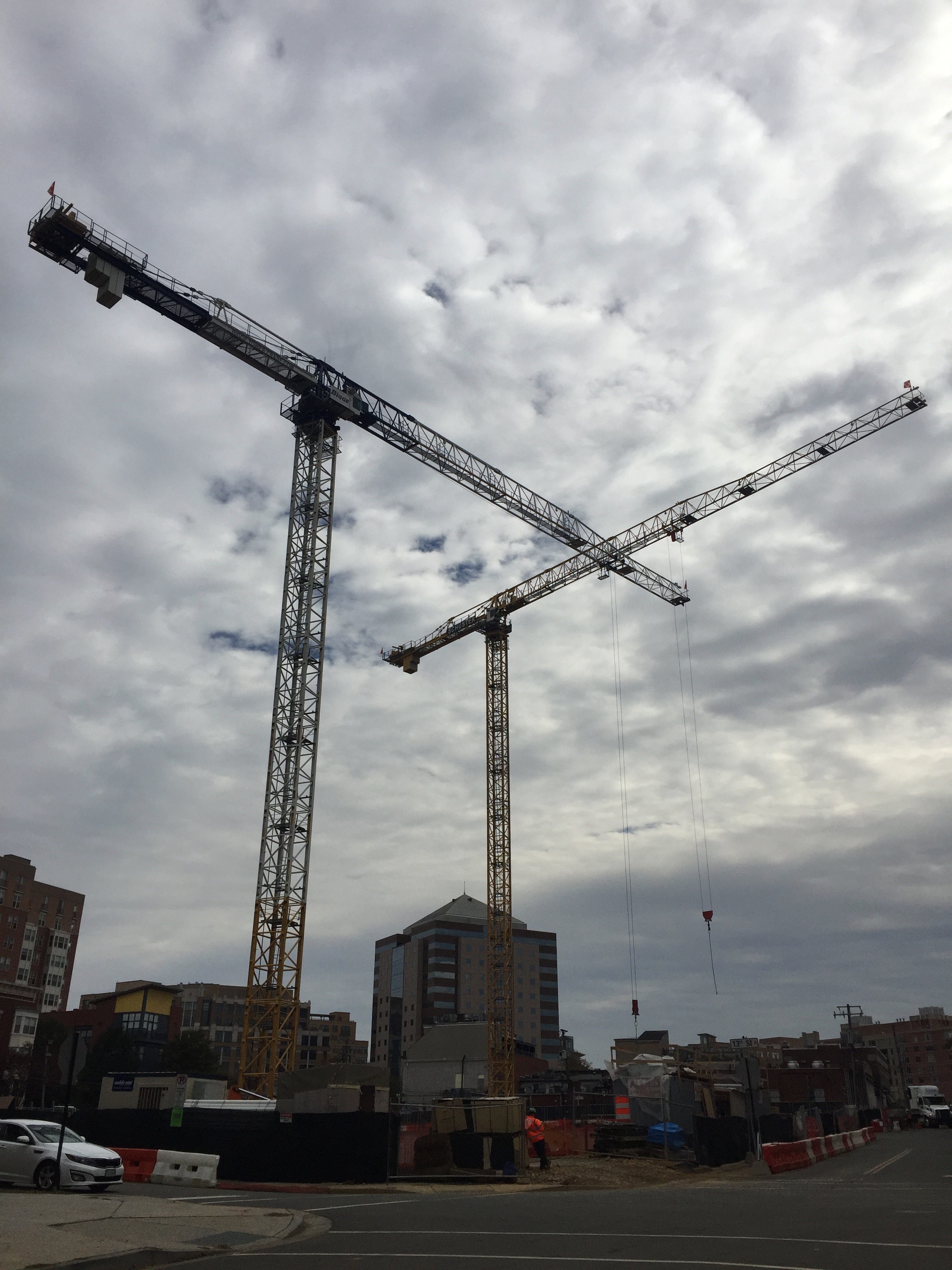
Street closures and high noise levels from construction on or near school grounds or other early childhood programs may disrupt the daily routine. Using the engineering habit of mind of optimism, defined as “a world view in which possibilities and opportunities can be found in every challenge and an understanding that technology can be improved” (Katehi et al., 2009, p. 152) educators at the Clarendon Child Care Center, Kathy Connell, Sarah Abu-El-Hawa, and Carly Gertler used the occasion of children’s interest in the cranes at the on-going construction to bring materials out to the playground for children to create their own cranes in 2-D and 3-D representations.
Welcome Kathy, Sarah, and Carly!
Our inspiration for this project presented itself in the construction site diagonally across the street from our playground. Each day as we walked to the playground our group of 16 four and five year-olds noticed the cranes and commented on their presence along with their characteristics. The children talked about how high the cranes stood, how the jibs extend out further from the site—even above the playground, the flapping flags at the ends of the jibs, and the hoists attached to the jibs that lifted building material from the flatbed trailers parked on the streets onto the worksite.
Kathy set out a short row of chairs on the playground and clipboards with paper and markers. The children accepted this invitation and drew their impressions of the cranes. We also set out Mobilo manipulatives on the picnic table and children built their own versions of cranes. By printing with paint using the Mobilo shapes children created 2-dimensional cranes. Photos of cranes by Kathy’s father contributed information on other types of cranes.
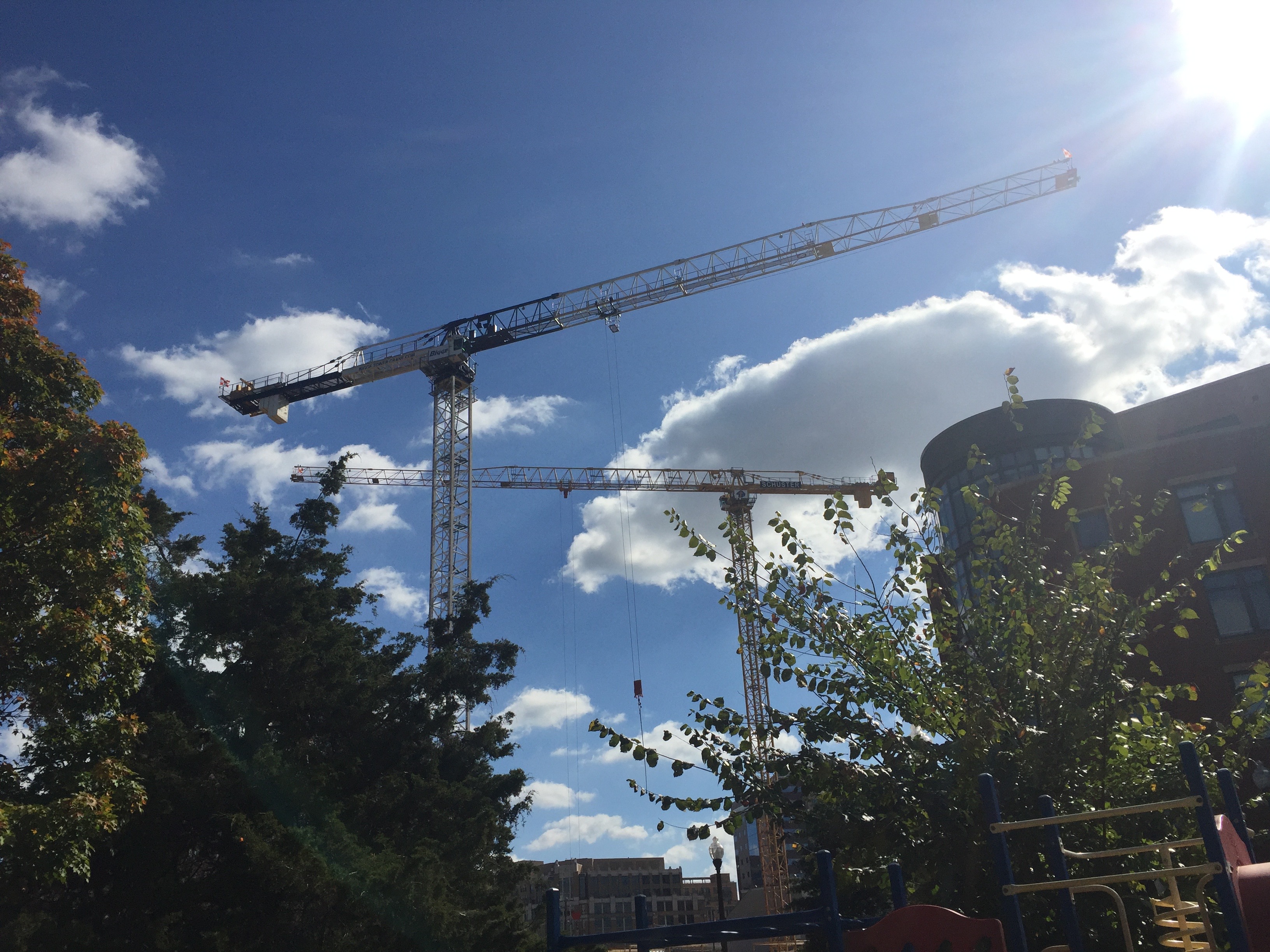
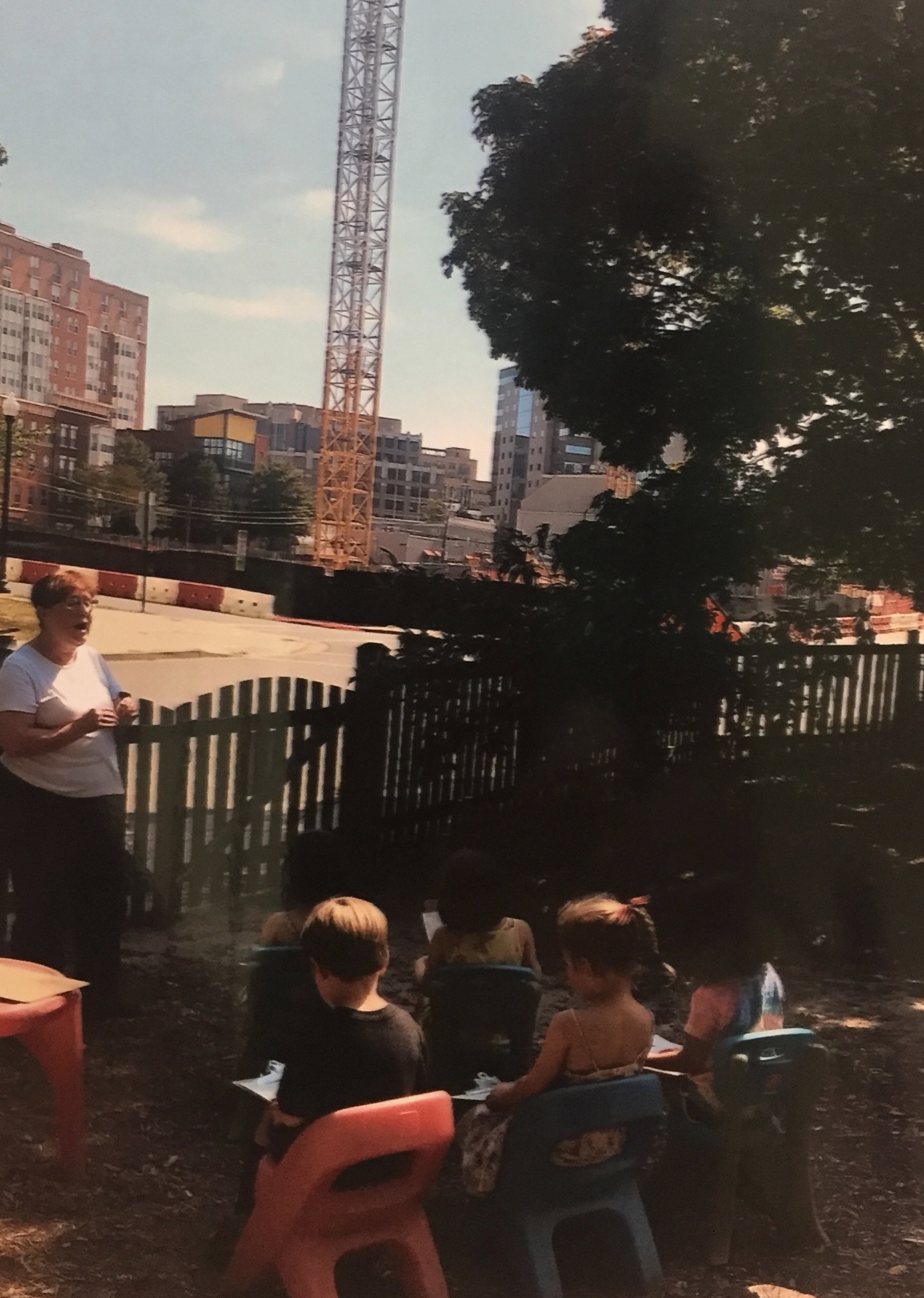
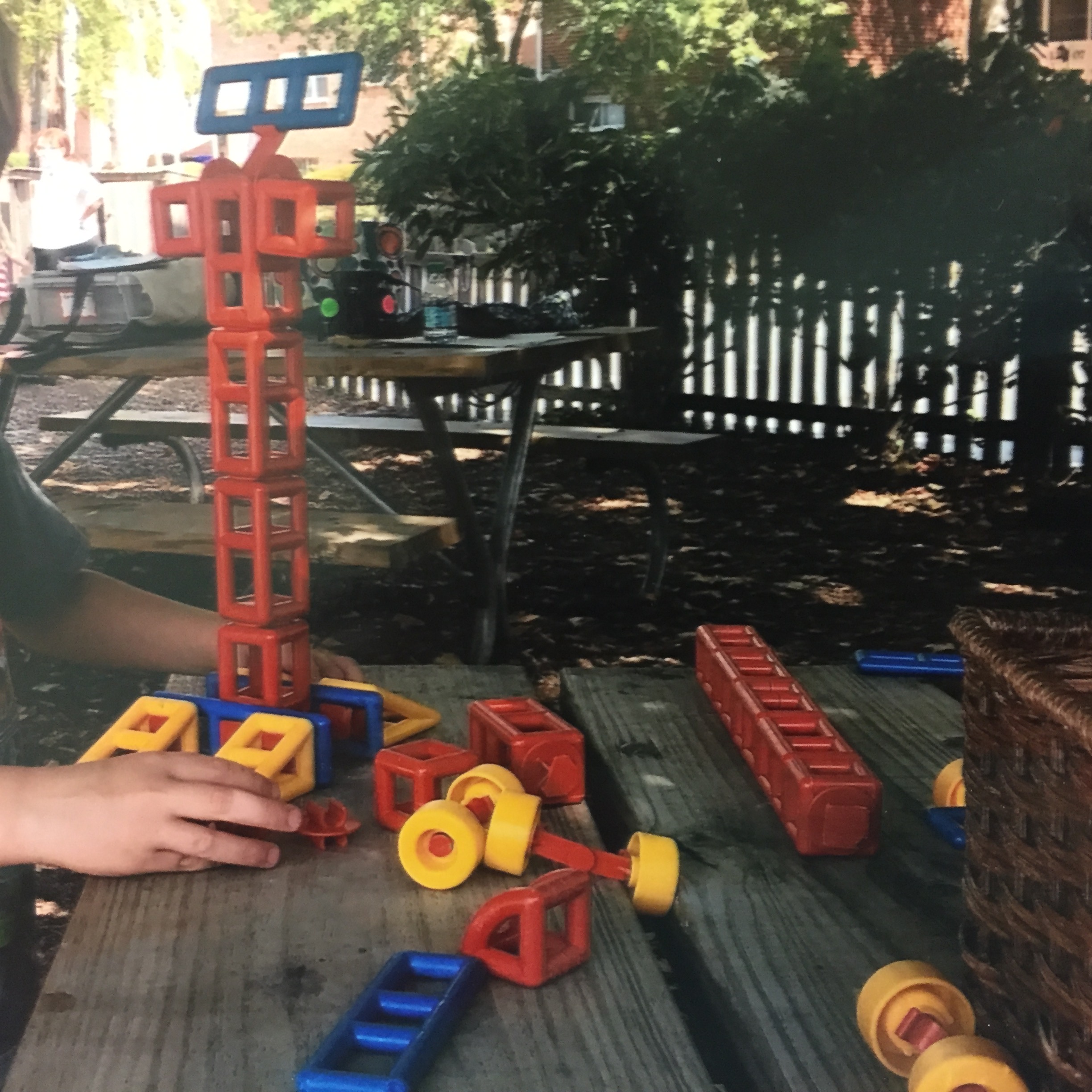
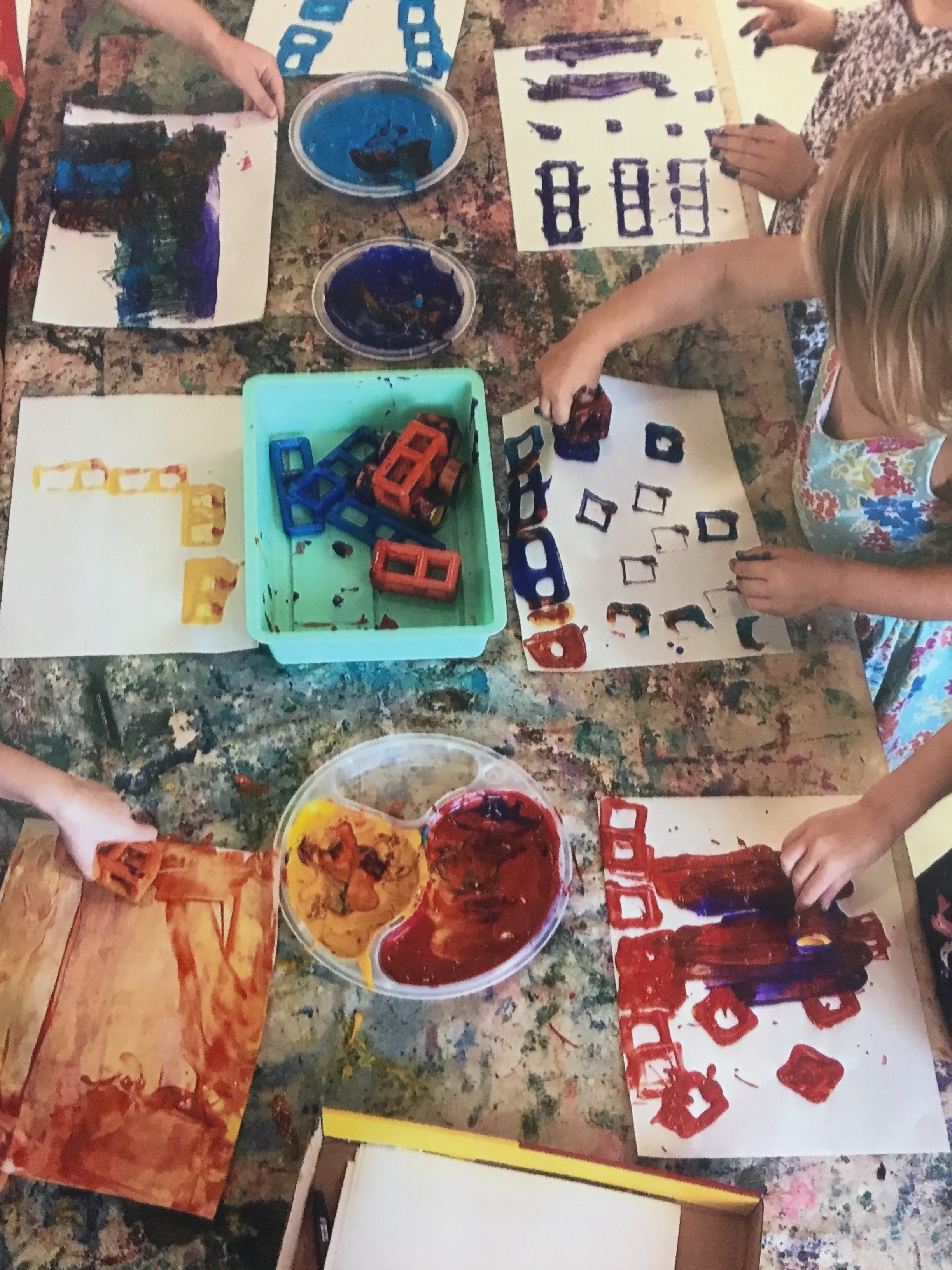
Photos by the teachers at Clarendon Child Care Center.
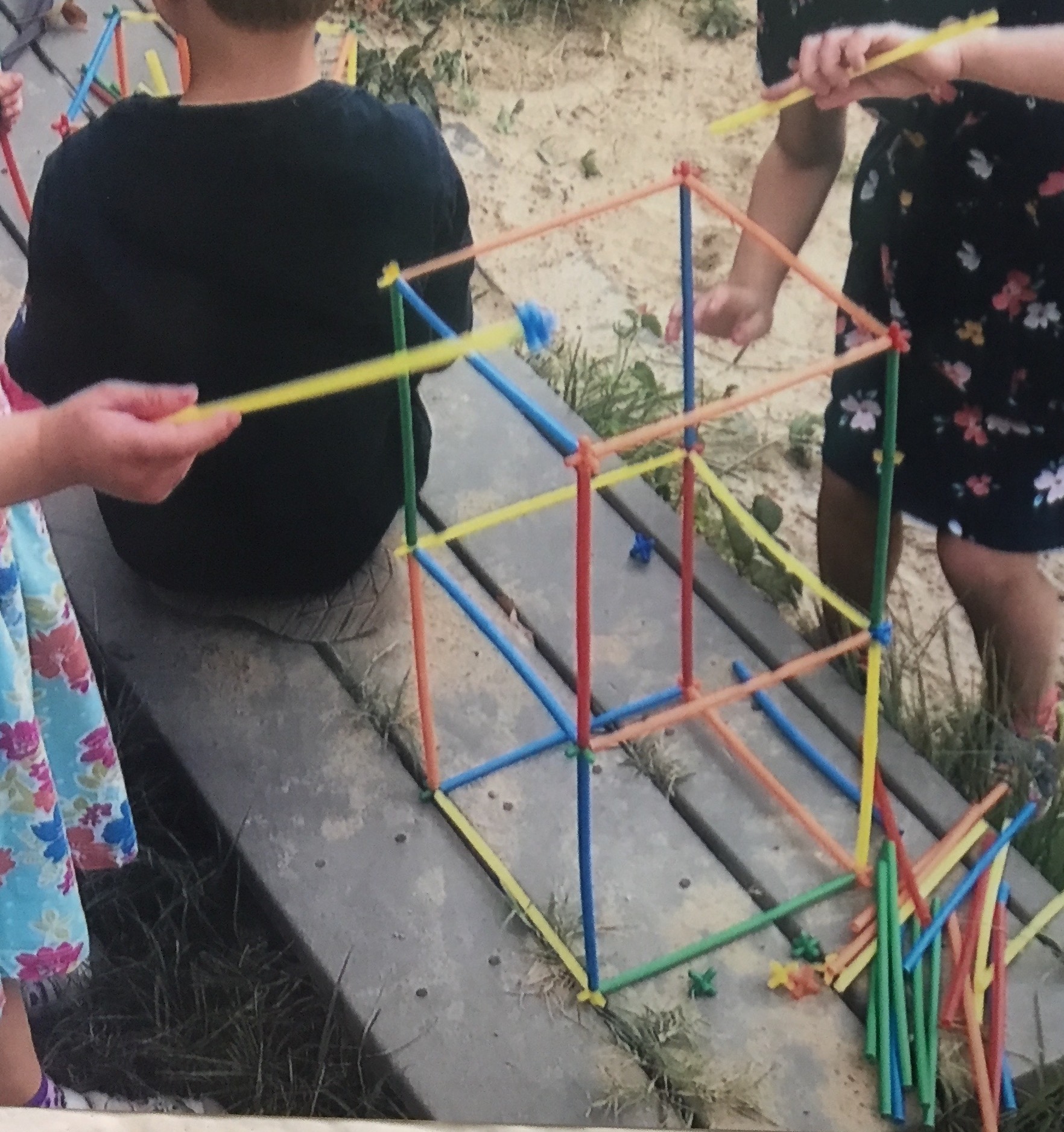
The next day we provided a straws and star connection building set and children continued to “build up.” Building with magnetic tiles in the morning sun on days that followed extended the children’s understanding of how large structures are made of smaller units. The light shining through the tiles cast jewel-toned shadow shapes surprising the children and added to their design. In discussion with the construction site manager teachers helped children think about the height of the crane by figuring out how many children would need to stand head-to-feet to be the same height as the (more than 200 foot tall) crane.
The teachers made the children’s work visible to their families, other classes, and the children themselves by creating a documentation panel on the wall. (The classes show their creativity in another way–the names they choose for themselves!) The children’s documentation shows that some are aware of the diagonal cross pieces in the jib and tower. I wonder if sometime they will explore the use of diagonals and triangles in structures, perhaps using K’nex or other building materials.
Resources
Katehi, Linda; Pearson, Greg; & Feder, Michael (Eds.). (2009). Engineering in K-12 education: Understanding the status and improving the prospects. Washington, DC: National Academies Press. https://www.nap.edu/catalog/12635/engineering-in-k-12-education-understanding-the-status-and-improving
Van Meeteren, Beth and Betty Zan. 2010. Revealing the Work of Young Engineers in Early Childhood Education. SEED Papers: Published Fall 2010, Early Childhood Research & Practice, University of Illinois at Urbana-Champaign. http://ecrp.uiuc.edu/beyond/seed/zan.html

Street closures and high noise levels from construction on or near school grounds or other early childhood programs may disrupt the daily routine.
Big Ideas, Small Budget
By Gabe Kraljevic
Posted on 2019-11-04
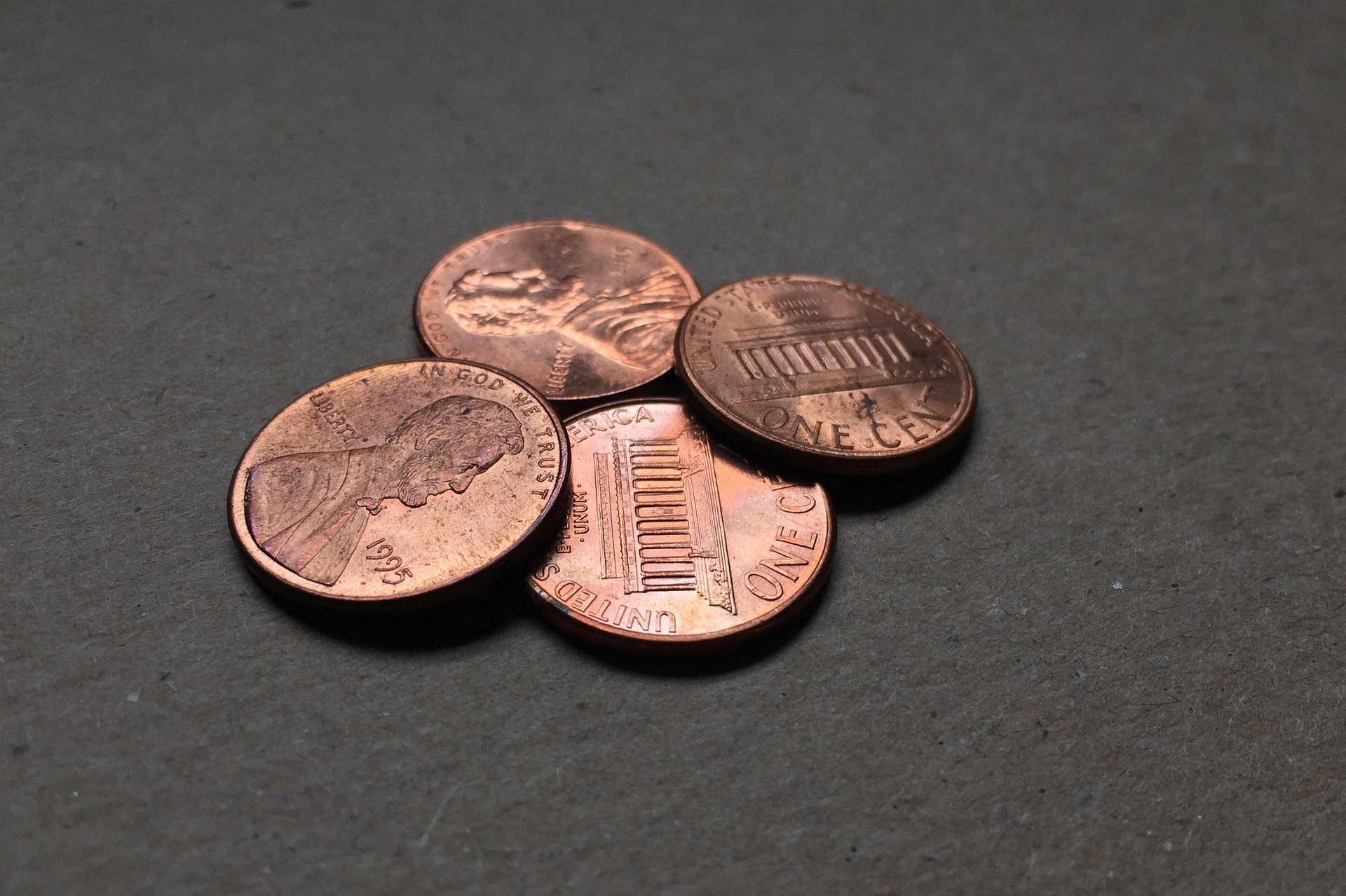 What advice would you give to first-year teachers who want to give life to their lessons, yet they have a budget that is small or non-existent?
What advice would you give to first-year teachers who want to give life to their lessons, yet they have a budget that is small or non-existent?
— J., Iowa
I always had living things in my classrooms— just going to a park or garden you can find sowbugs (pill bugs), lady beetles, earthworms, and more.
Seeds are easy to come by, and a single package of, say, tomato seeds can go a long way. You can ask for donations of equipment, such as tubs, aquarium supplies, soil, and sand in your school newsletter, website or in communications to students’ families. Consider asking for old cell phones that can be repurposed as cameras for observations. I often would get dissection specimens of fish, oysters, clams, even crabs and lobsters by going to the local grocery store and explaining how I could use any of the creatures that died in their fresh seafood section! They would freeze them and I would pick them up.
There are many, many, many shoestring budget lessons out there that don’t need fancy equipment. My classes would make planispheres—“sky maps” of constellations that you dial to the correct date. You can download one for free and then all you need is paper, glue and card stock (I repurposed file folders in place of card stock). A bit of searching on the topics you teach will net you many cheap-to-make items like this that become little projects in themselves.
Bring in classroom speakers! There are many organizations that have free travelling shows and experts that will come to your classroom. Check out the websites of nature centers, hospitals, zoos, parks, societies, and universities. A bird rehabilitation center in my city would bring owls into the classroom! Free!
Hope this helps!
Image by Chris Pastrick from Pixabay
 What advice would you give to first-year teachers who want to give life to their lessons, yet they have a budget that is small or non-existent?
What advice would you give to first-year teachers who want to give life to their lessons, yet they have a budget that is small or non-existent?
— J., Iowa
I always had living things in my classrooms— just going to a park or garden you can find sowbugs (pill bugs), lady beetles, earthworms, and more.
Science Education in Prison
By Debra Shapiro
Posted on 2019-11-03
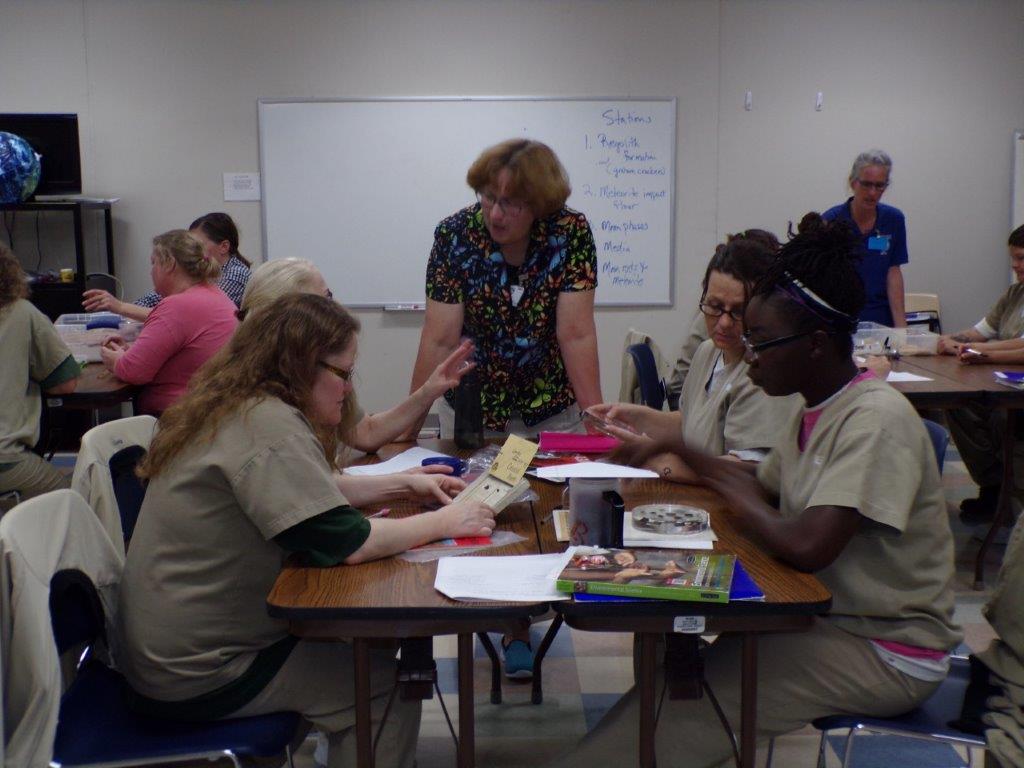
Students at Chillicothe Women’s Correctional Center in Chillicothe, Missouri, examine
lunar rocks from NASA in Mary Haskins’ environmental science course. Photo credit: SHONA SIMPSON, CCC STAFF
When Rockhurst University in Kansas City, Missouri, started an education program last spring at the Chillicothe Women’s Correctional Center, biology professor Mary Haskins says she “jumped” at the chance to teach a semester of environmental science there. “The work is incredibly rewarding and truly life changing for all involved, especially the offenders,” she maintains.
“We provide courses…to both the offenders and to the [Chillicothe] staff ” in a separate class because “most staff don’t have college degrees, and no colleges are nearby….It’s an opportunity for both groups to earn college credit,” Haskins explains.
Only 20 prisoners were permitted to take Haskins’ course. Chillicothe is a mixed security prison, so Haskins taught both violent and nonviolent offenders ranging in age from 20 to 50. She says it is standard procedure for all volunteers to wear “a body alarm for protection…and there was a camera in the room so our activities could be monitored.”
One challenge Haskins faced was equipment approval. For her spring 2019 course, she had to have a November “‘show and describe’ session with the warden to identify ‘types’ of equipment that might be used.” In December she submitted “a complete equipment list for all of the January 2019 labs (types of equipment and numbers of all items).” She had to submit equipment lists each month for the next month’s labs thereafter.
“I was also allowed to show environmental DVDs, but the lights had to stay on, so image contrast was a challenge,” Haskins reports. And after clearing security to enter the prison, “I didn’t want to forget anything because I couldn’t run back to the university to pick it up.
“In May, I wanted to bring in lunar rocks and meteorites from NASA, a hammer, 40 pounds of flour, a laptop, a projector, and [many] other items. I made that request in March, thus allowing my long list of equipment ample time for analysis and approval, since laptops were not traditionally allowed. All of the items, including the hammer, were approved (it may have helped that I also had five assistants that day, so they could be assured the activities and equipment would be monitored). All items were counted each week by the guard at the front desk and checked against the memorandum of agreement for entry/exit,” Haskins relates.
“The limitations are restrictive and require creativity [and] a willingness to substitute some alternative labs for traditional ones,” she observes. One successful project was a benthic research project. “I placed leaf packs in a river in November, retrieved them in January, and hauled the leaf packs to the prison for analysis. Students then sorted and analyzed the data, and wrote research papers on their results.”
Sometimes Haskins’ students surprised her. “Several offenders wanted additional information and used their telephone time to ask family and friends to look up [information online]. So although the offenders couldn’t directly access the internet, they did manage to find far more information than I had expected.”
Afterward, “we prepared two posters from that work, which I presented at different scientific meetings on their behalf,” Haskins relates. “I was very proud of them, and they felt very accomplished.”
The same could be said of some male prisoners at Tomoka Correctional Institution in Daytona Beach, Florida— even ones serving life sentences—who “cried [tears of joy] when they earned their GEDs,” recalls Pam Walker, who taught “biology, physics, and chemistry to prepare them for their GEDs.” She says she would do “demonstrations for them,” such as “showing surface tension using water droplets on a penny….[ In physics, they had to] use one piece of paper to create a tall or strong structure. [I gave them] toothpicks and water-based glue to build things with and test them with weights. I limited how much glue everyone had.”
In another lab, Walker says she taught prisoners “about scientific [methods] of approaching a problem” by having them weigh a piece of gum, “chew it for 10 minutes, and weigh it again to see where the weight went.” In addition to science, “I tried to teach them life skills, how to read a phone bill and balance a checkbook, to give them a basic education,” she notes.
When Andrea d’Aquino, a graduate student in the Department of Chemistry at Northwestern University in Evanston, Illinois, taught incarcerated males at Stateville Correctional Center in Crest Hill, Illinois, as part of Northwestern’s Prison Education Program (NPEP), she made sure her general chemistry course “would teach students about how the world works, through the lens of a chemist. I focus on topics students can relate to and care about. I want to ensure they can use what they learn.”
NPEP courses are credit-bearing and taught with content and expectations equivalent to those at Northwestern. To comply with Stateville’s equipment limitations, d’Aquino and her co-teacher “make videos of all of the labs to show in class. [In the videos,] we do everything an undergraduate would do, [including] pre-labs and post-labs,” she explains.
“Trying to tailor your teaching to different learning styles and backgrounds [is challenging]. Some students have no or little chemistry experience, while others are quite proficient at it,” d’Aquino acknowledges.
Differentiation was also arduous for Kristen Lee, now a physics teacher at Avondale High School in Auburn Hills, Michigan. When she taught science for Spectrum Juvenile Justice Services at the Calumet and Lincoln Centers in Highland Park, Michigan, her students were male youth ages 12 to 21 who were separated into eight “pods” by criminal offense, “so there was a substance abuse pod, a sex offender pod, [for example],” she explains.
Each pod could have both middle level and high school students. “Each grade level did [its] own thing. I had only one group doing a lab each day; the other students [in the pod] did a worksheet,” Lee recalls. She taught physical science to the middle level students and biology, chemistry, and Earth science to the older students, so she taught different subjects in the same classroom. And “everything had to be portable; the teachers moved from classroom to classroom,” she notes.
“The IT [information technology] people made websites for virtual dissections available. I had to sit next to [students] to make sure they stayed on the pages they were supposed to stay on,” Lee relates. “I did a lot of modeling with paper or other safe materials.” And for a thermodynamics lesson, “we made ice cream, which the kids really liked. There’s nothing like eating ice cream at 9 a.m. in science class,” Lee asserts.
This article originally appeared in the November 2019 issue of NSTA Reports, the member newspaper of the National Science Teachers Association. Each month, NSTA members receive NSTA Reports, featuring news on science education, the association, and more. Not a member? Learn how NSTA can help you become the best teacher of science you can be.

Students at Chillicothe Women’s Correctional Center in Chillicothe, Missouri, examine
lunar rocks from NASA in Mary Haskins’ environmental science course. Photo credit: SHONA SIMPSON, CCC STAFF
Shifting to the NGSS: Professional Book Study for Elementary School Teachers
Are you an elementary school teacher working to enhance your knowledge and understanding of the Next Generation Science Standards (NGSS)? Register to participate in the Shifting to the NGSS: Professional Book Study, taking place in April/May, 2020!
Are you an elementary school teacher working to enhance your knowledge and understanding of the Next Generation Science Standards (NGSS)? Register to participate in the Shifting to the NGSS: Professional Book Study, taking place in April/May, 2020!
Are you an elementary school teacher working to enhance your knowledge and understanding of the Next Generation Science Standards (NGSS)? Register to participate in the Shifting to the NGSS: Professional Book Study, taking place in April/May, 2020!
Are you an elementary school teacher working to enhance your knowledge and understanding of the Next Generation Science Standards (NGSS)? Register to participate in the Shifting to the NGSS: Professional Book Study, taking place in April/May, 2020!



